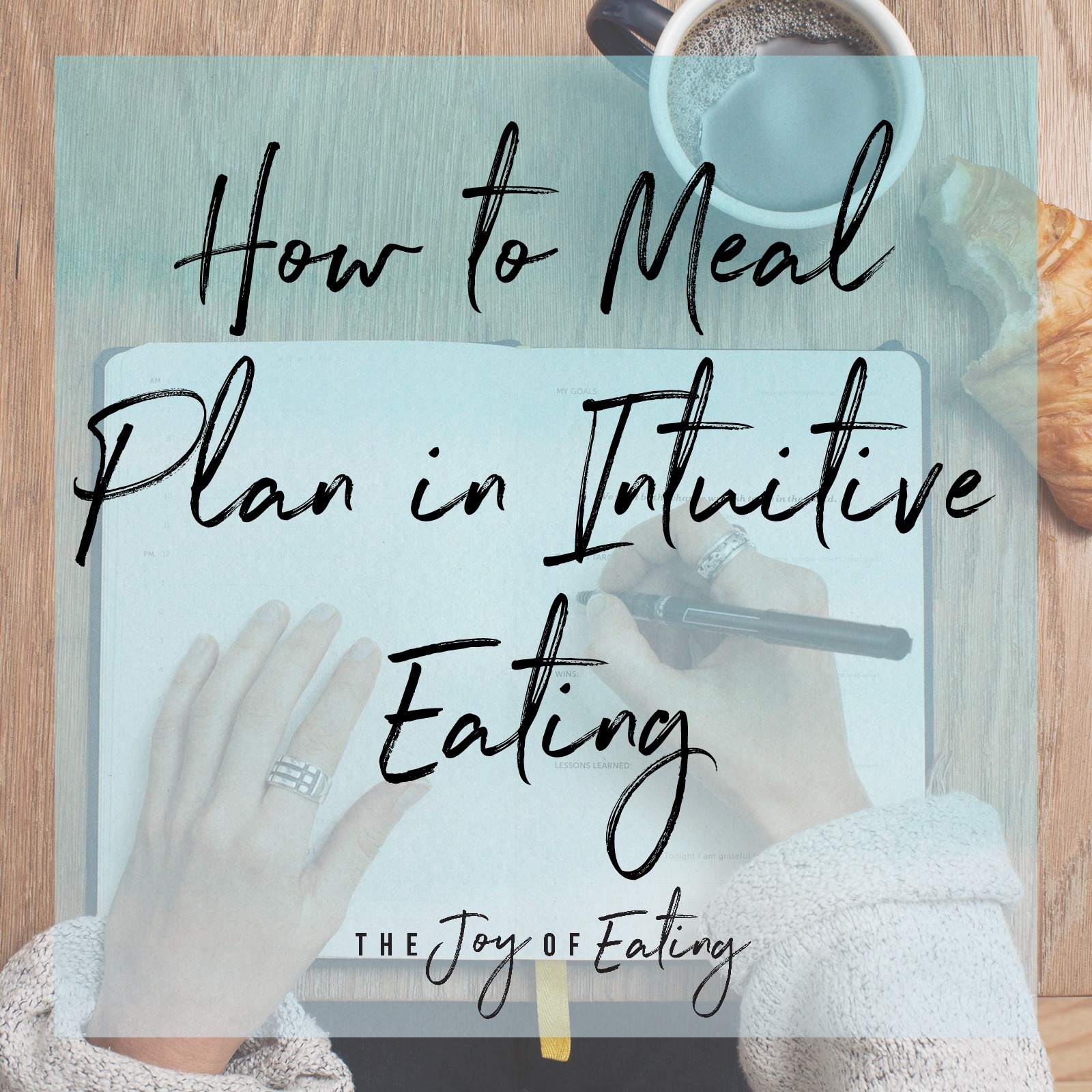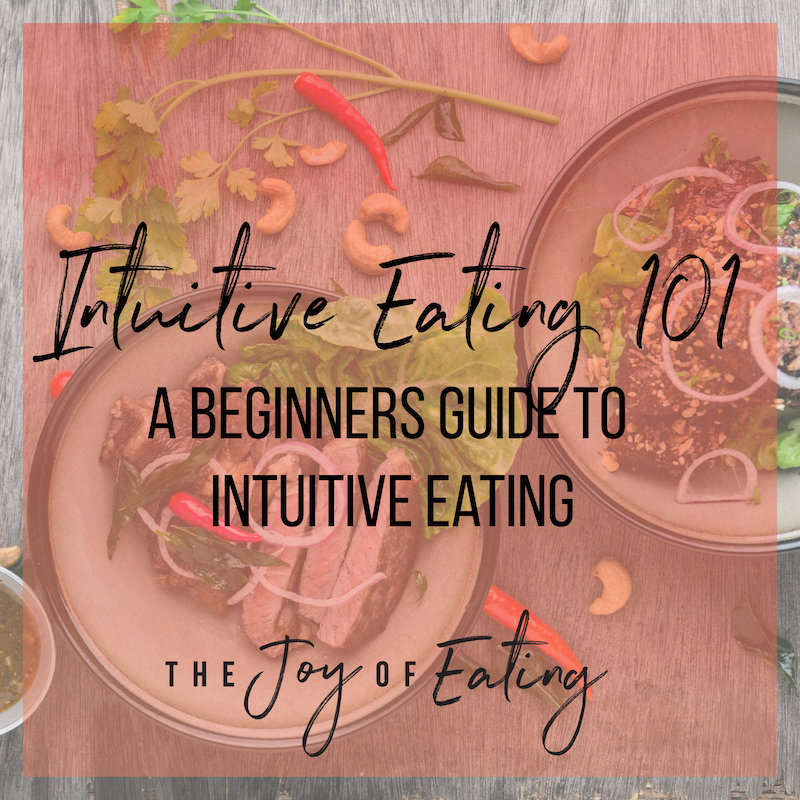Meal Planning 101: How to Meal Plan in Intuitive Eating
A big part of Intuitive Eating is learning to make decisions about what to eat based on what sounds and feels good in the moment. It may seem like intuitive eating and meal planning conflict, but I actually think they go hand in hand. When meal planning is done in a way that allows for flexibility and takes pleasure into consideration, meal planning can be a powerful ally in making peace with food. Learn how to meal plan in intuitive eating!
This post was originally published in August 2015. Text and images have been updated.
A big part of Intuitive Eating is learning to make decisions about what to eat based on what sounds and feels good in the moment. It may seem like intuitive eating and meal planning conflict, but I actually think they go hand in hand. When meal planning is done in a way that allows for flexibility and takes pleasure into consideration, meal planning can be a powerful ally in making peace with food.
If you live in NYC with basically every cuisine and type of food within a ten-block radius and have unlimited funds to order out, then yes, you can make food decisions 100% based on what sounds good in the moment because you have access to all the foods. For the rest of us, we need some semblance of a plan to make sure we have a variety of tasty foods available when hunger hits. Without a plan to have access to food, you'll be stuck making decisions about what to eat when your blood sugar is already running low. When your blood sugar is low and your brain is in need of nourishment, it's really hard to make a rational decision about what to eat.
Where meal planning goes wrong is when it's too rigid. Spending your entire Sunday on pinterest picking out recipes, creating a calendar of weekly meals, shopping, then prepping is...a lot. And what happens when Wednesday comes and you just have zero desire to eat barbecue salmon tacos and really you're just craving Thai? Or when you get called into a late meeting and get home ravenously hungry, will you still want to prepare that vegetable lasagna from scratch?
Meal Preparedness vs. Meal Planning
I like to think of meal planning more like meal preparedness. Because being prepared is really the point of it. Meal preparedness allows for you to have structure and makes it easy to honor your hunger because food is always available. It allows for you to build pleasure into your meals when you think about what foods you enjoy, not what you think you should eat. It's helpful for ensuring variety. And if you're working through eating disorder recovery or making peace with food in the Intuitive Eating process, planning ahead ensures you're prepared to build food challenges into your week.
With Intuitive Eating, meal planning isn't based on what you think you should eat, but rather what you want to eat. There's no calories or points or whatever involved in the planning process.
Clients often share that they've tried meal planning in the past but got overwhelmed and gave up because it was taking hours and hours out of their weekend. It's no wonder when you have a dozen different diet rules you're trying to accommodate for! With meal planning for intuitive eating, nutrition may be a part of your decisions, but it's gentle nutrition. For example, I almost always include a vegetable in each meal when meal planning. If in looking at my week, I notice it's a bit skimpy in whole grains, I might purchase a whole grain pizza crust for my planned pizza night. Or if I realize I've been eating a lot of meat and cheese as of late, I might swap chicken for tofu in the stir fry I'm making.
My Strategy for Meal Planing in Intuitive Eating
How I meal plan can vary a bit based on whether I'm testing recipes for the blog or a brand I'm working with - which I usually am. But if I'm not doing recipe development, here's what I do:
Pick 2-4 "recipe" meals.
Depending on whether my husband or I are traveling or have dinner plans, I'll pick 2-4 meals that are based on a recipe. I try to aim for 1-2 brand new recipes, which helps get my creativity going and gets me that variety I crave. For the others, I pick simple recipes that I basically already know how to make, like an old recipe from the blog. For example, if I pick a recipe for a stir-fry, that's super easy because I'm really familiar with how to stir-fry, and usually just have to glance at the recipe a few times during cooking. Or, I might pick out a recipe I know by heart, and try to switch it up a bit using different spices or condiments - again, this helps keep my variety craving taste buds happy.
Have 3-4 pantry meals on hand.
Pantry meals are meals you can throw together with shelf stable ingredients and/or leftovers. I like to have a few different options available for easy meals. One of my favorites is sauteed onions and frozen spinach tossed with whole grain pasta and canned tuna. I'll add black olives and sun-dried tomatoes to dress it up. This is a great place to use up leftovers and prevent food waste.
Then we have room to go out to eat once a twice a week. I find that this leaves a lot of flexibility, because I don't have so much food on hand that I have to eat before it goes bad - if I'm craving pizza, we can just go out and get pizza and not worry about the spring mix starting to wilt.
On top of that, I always have ingredients for at least a couple different breakfast options, one sweet and one savory. Oatmeal, eggs, frozen fruit, yogurt, bread, and granola are pantry staples at our house, so usually it’s some combination of those. But if I’m getting bored with that, I might pick out a new recipe or a different breakfast food.
Plus, there’s snacks. We always have bars, dried fruit, nuts, fruit, yogurt, and granola on hand, so I usually pick up a couple other savory snacks to go with that, or plan to snack on leftovers.
Other Strategies for How to Meal Plan in Intuitive Eating
Other strategies might work better for you. Some people are ok with eating a lot of the same foods and enjoy routine, while others want to try lots of different foods. Some people are cooking for big families with lots of different taste preferences, while others are cooking for one or two.
Here's some other strategies I've heard that may be useful:
Theme nights
I've heard of a few families doing this and it's such a great idea! Each night of the week is a different theme (i.e. Taco Tuesday, Pasta Wednesday, Roasted Chicken Sunday), and it helps a lot as you're trying to come up with meal ideas. You can stick with the usual ground beef taco recipe, or easily switch things up by doing a different protein and/or adding in a few different toppings.
5-4-3-2-1 plan
This is my friend Kylie's plan for grocery shopping when you don't have a plan, and I often pull it out when I don't feel like meal planning. The only change I make is that I get 5 vegetables and 3 carbs, since we already have a ton of grains and pasta in the pantry.
Organized meal prep
Some people really do well by planning out each days meals and prepping on the weekend. While it feels like a lot for me, others like that structure. My friend Lindsey has some really great resources for making meal planning/prep more streamlined and simplified.
Outsource
If you can afford it, outsource! Get a meal delivery service, like Blue Apron or Hello Fresh. I also really like Fresh 20, which provides weekly meal plans for 5 budget friendly meals using 20 different ingredients that are really simple to make. The downside to this with Intuitive Eating is that you don't get to pick meals based on what sounds good to you, but I think there's enough flexibility in there to where you can go out to eat or pick something up to make if you're craving something different.
At the end of the day, whatever you decide to do for meal planning, it needs to have some flexibility built in. Think of it as flexible structure.
More Tips for How to Meal Plan in Intuitive Eating
Cook once, eat twice
Plan for leftovers! I like to use mine for lunch, or you can always cook extra of one item, and plan to use it for leftovers later in the week. For example, I made a pizza topped with sauteed fennel, corn and tomatoes earlier in the week, and later, I used the extra sauteed vegetables to round out a pasta meal kit (this one by Modern Table Meals - thanks for the samples!)
Freeze extras
It makes sense if you're making something like soup or chili to prepare extra, but you probably don't want to eat chili for a week. Just freeze the extras, which are great a month later when you don't feel like cooking!
Purchase food that lasts longer
You'll have more flexibility if you don't feel like you have to eat the food your purchased before it goes bad. Get sturdier vegetables, like cauliflower, zucchini, or carrots, or even shop frozen/canned.
Get grocery deliveries
The most annoying part of meal planning is forgetting something, which I inevitably do at least once a week. Usually I bug my husband to stop by the store on the way home from work, but also, grocery delivery, like Shipt (client) is a huge time-saver.
Think about how much time you have to cook
Like, if you know you're working long hours one week, don't plan out lasagna from scratch. Go get yourself some Stouffers.
Think about what ingredients you already have on hand
Reduce food waste by looking at what ingredients you already have on hand!
Would love to hear from you! Do you meal plan? What's difficult about it? What's helpful?





